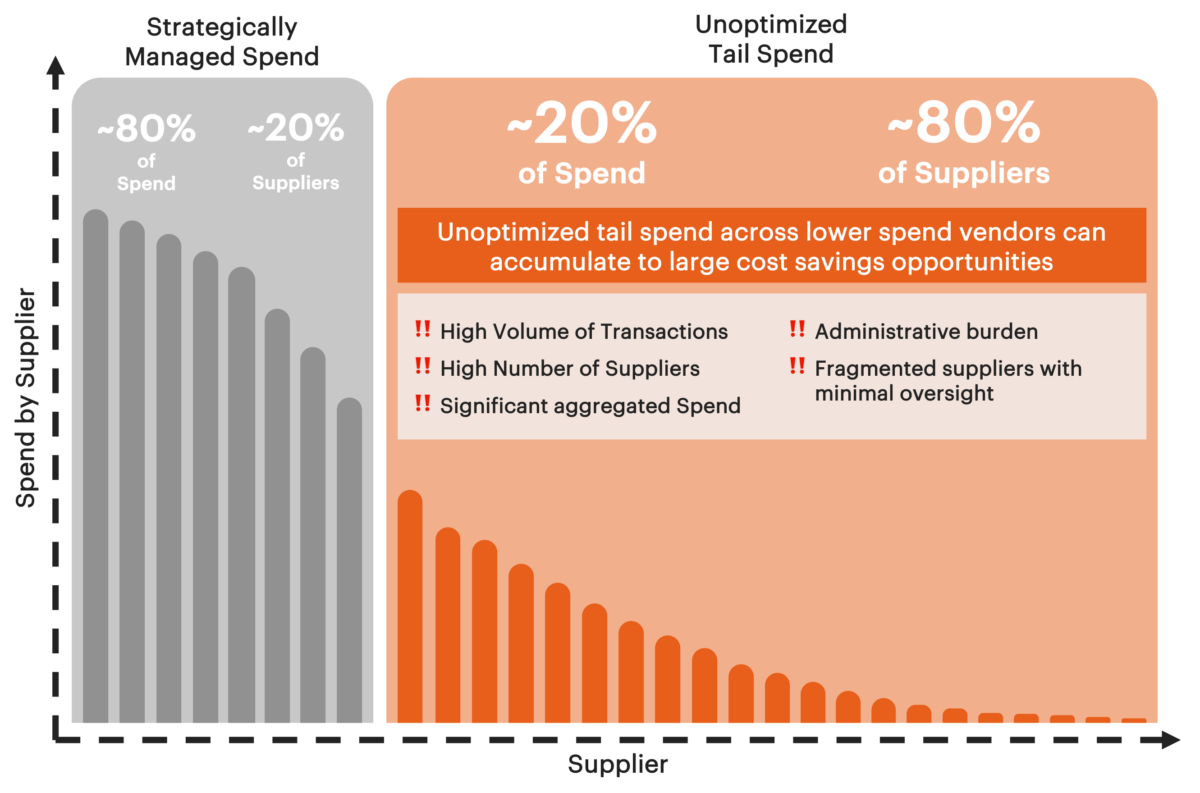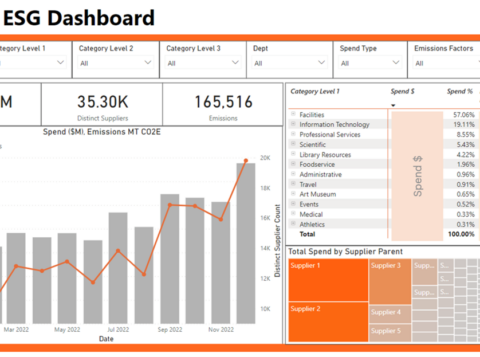How Tail Spend Undermines Your Strategic Sourcing Goals – And What to Do About It
If you work in procurement, you’ve probably seen it before: a well-crafted strategic sourcing plan that looks great on paper but is missing a critical piece of the puzzle. Despite your team’s best efforts, a surprising portion of spend slips through the cracks. It’s not malicious. It’s not even intentional. It’s just tail spend. And it’s hurting your bottom line.
Tail spend, the thousands of low-dollar purchases spread across departments, campuses, or business units—isn’t just a bookkeeping headache; it’s a strategic risk. It quietly chips away at your margins, muddies forecasts, and weakens procurement’s ability to deliver enterprise-wide value. Left unmanaged, it undermines everything from vendor negotiations to budget visibility. And for industries like higher education and healthcare, where decentralization and compliance pressures run high, ignoring it isn’t an option.
At AArete, we’ve seen firsthand how overlooked tail spend can quietly drain millions of dollars in value from organizations, but we’ve also seen how the right strategy—grounded in data, automation, and stakeholder alignment—can turn that liability into a source of savings, control, and resilience.
In this piece, we’ll dig into strategic sourcing challenges of tail spend; how it shows up in complex environments like higher education, healthcare, and others; and the practical steps you can take to bring it under control, without turning procurement into a bottleneck.
Exploring This Article

The Hidden Cost of Strategic Fragmentation
When every department or unit has their own way of purchasing low-dollar goods and services, it results in hidden costs, including:
- Missed volume discounts due to fragmented buying
- Overlooked vendors and ongoing costs
- Sourcing policies that don’t get enforced
- Difficulty running meaningful spend analytics
Strategic fragmentation creates the illusion of control while slowly picking away at your strategy. For executives, this fragmentation undermines not only cost control but trust in procurement’s ability to deliver on financial, compliance, and performance goals. And with shrinking budgets and heightened compliance demands, organizations can no longer afford to let these hidden costs go unmanaged.
What Is Tail Spend in Procurement?
Tail spend refers to the smaller, often ad hoc purchases that don’t go through formal sourcing processes. On their own, they may seem inconsequential, but, collectively, tail spend can represent up to 20% of your total vendor spend.

Common characteristics of tail spend include:
- High number of low-volume suppliers
- One-off or maverick purchases
- Lack of contract or pricing standards
- Heavy reliance on manual processes
Why Tail Spend Is So Hard to Control
Even the most disciplined procurement teams struggle to manage tail spend. It’s not just about the dollars; it’s about where and how that spend happens. Tail spend often lives outside the core systems and procurement cost reduction strategies teams rely on to drive value, weakening efforts to manage spend through strategic sourcing. Some of the challenges include:

- Fragmented Data:
Spend is scattered across company cards, spreadsheets, emails, and siloed systems, making it difficult to get a complete picture or plan categories effectively. - Decentralized Ownership:
Teams and departments buy what they need, when they need it, often bypassing preferred suppliers and missing out on rebates, volume discounts, or contract terms. - Supplier Overload:
Without centralized oversight, the vendor list grows unchecked. Too many vendors doing too little undermines your ability to negotiate favorable terms or standardize services. - Compliance and Audit Risk:
Many vendors acquired in this way are unvetted or lack proper documentation, which increases exposure to data breaches, regulatory violations, and audit flags. - Operational Drag:
Even low-dollar transactions carry high operational friction when the same systems and reviews apply, as they would for large vendors. With extra suppliers, this added time is wasted on transactions that should be fast and easy if everything was more streamlined.
Learn more about How Small Vendors Can Drive Big Savings
Tail Spend Management Traps to Avoid
Identifying your tail spend issues, like the ones mentioned above, is only the beginning. As you move into solving them, whether through technology, new processes, or vendor rationalization, it’s easy to create new problems in the process. Many organizations underestimate how complex and cross-functional tail spend solutions really are.
Here are some of the most common pitfalls to avoid as you begin to take control:
- Overcentralizing and Frustrating Local Teams
Taking control doesn’t mean taking away autonomy. Overly rigid controls can create resistance and lead to even more shadow purchasing unauthorized purchases made outside of standard procedures. - Trying to Manage Tail Spend in Spreadsheets
Tail spend is dynamic, high-volume, and unstructured. Manual tracking will only take you so far, and it will quickly become unscalable. - Treating It Like a One-and-Done Cleanup
Tail spend isn’t a set-it-and-forget-it project. It requires ongoing governance, stakeholder alignment, and continuous optimization. - Skipping Risk Reviews for Small Vendors
Just because spending is low doesn’t mean the risk is. Small or infrequent vendors can still pose data privacy, security, or compliance risks.
Tail spend management isn’t only about cost savings; it’s about control. And effective control comes from sustainable strategies, not shortcuts.

Tail Spend Challenges by Industry
Tail spend is a universal procurement issue, but how it shows up, and why it persists, often varies by industry. While many organizations wrestle with the same root causes—decentralized purchasing, inconsistent policy enforcement, and fragmented supplier ecosystems—the stakes, constraints, and solutions differ by sector.
Whether you’re a university juggling grant restrictions, a hospital navigating the Health Insurance Portability and Accountability Act (HIPAA), a financial services firm managing a sprawling vendor base across departments, or a federal agency bound by regulatory frameworks like the Federal Acquisition Regulation (FAR), tail spend has a way of flying under the radar. Understanding these nuances is key to building a management strategy that actually sticks.
Below, we explore how tail spend manifests across four distinct industries—and where procurement leaders can take action.
Tail Spend in Higher Education
Few environments are more decentralized than higher education. Every college, research lab, or academic department has its own processes, grant funding sources, and vendor preferences. Procurement teams are often left to react rather than lead.

Common tail spend issues in higher education include:
- Different departments using redundant suppliers
- Grant-funded purchases made outside standard protocols
- IT and software purchases and subscriptions handled independently from central procurement
- One-off services for events, instruction, and research
Tail spend in higher education creates blind spots that make it hard to forecast spend, enforce policy, or report accurately.
Learn more about our work in Higher Education
Healthcare Tail Spend
Healthcare payers and providers face a unique set of tail spend challenges. Their vendors often span many departments, like claims, IT, marketing, and facilities, with very little central coordination. And because compliance requirements like HIPAA are non-negotiable, unvetted vendors can create serious risk.

Specific challenges in healthcare tail spend include:
- Minimal oversight of niche vendors across administrative and clinical functions
- Siloed systems that prevent cross-functional spend visibility
- Missed savings on commoditized services like office supplies or staff augmentation
- Risk of non-compliance due to unmanaged vendor relationships
AArete Uncovers $15M+ in Annual Savings for Health Insurer Through Strategic Tail Spend Optimization
One health insurance company recently engaged AArete to perform a detailed review of $266M in strategic sourcing tail spend. The engagement focused on the IT, administrative spend, contingent labor, and facilities categories.
Through invoice, contract, and AP spend review, AArete deployed multiple strategies to capture value from their tail spend. We reviewed:
- Supplier Rationalization
- Renegotiation
- Service Redundancy
- Early Payment Discounts
- Contractual KPIs
From this audit and the changes that ensued, the client was able to capture $15M+ in annual cost savings, rationalize hundreds of suppliers, and strengthen their toolset.
Learn more about our work in Healthcare
Financial Services Tail Spend
Financial services institutions—from large banks to regional credit unions and investment firms—operate in highly regulated environments with diverse operational needs. Tail spend in this sector often spans a wide range of categories, including marketing agencies, IT consultants, office services, legal support, and specialized software vendors. Despite strict procurement policies, fragmented purchasing still happens at the departmental level, often driven by urgency or legacy vendor relationships.

Key financial services tail spend challenges include:
- Department-led purchases that bypass centralized procurement
- Excessive vendor count for services like data subscriptions, compliance audits, and tech support
- One-off engagements with consultants or law firms that lack pricing consistency
- Redundant software tools or platforms with overlapping capabilities
- Low visibility into aggregate vendor contracts across business units or regions
This decentralized purchasing model erodes negotiating power, introduces compliance risks, and drives up operational costs. Financial institutions that take control of tail spend can not only reduce cost leakage but also tighten audit trails, improve risk posture, and support more strategic supplier relationships.
AArete Helps Global Financial Services Firm Recover $2M in Vendor Overpayments Through AI-Driven Tail Spend Optimization
As part of a strategic sourcing engagement for a Global Financial Services Firm, AArete recently reviewed $200M of tail spend to implement process improvements for strategic management of their tail spend vendors.
AArete implemented a new process and system for this bank to manage their tail spend vendors. This included:
- Implementing AI tools to do invoice review
- Setting up a tool to enhance spend review
- Establishing operational guidelines for sustained management
A byproduct from this was the realization of unique savings strategies. One example was capturing sales tax recoupment. Our team compared invoices and AP data and revealed inconsistencies across sales tax payments year-to-year for software licenses and maintenance support of the same products. AArete’s team qualified the identified opportunities with client stakeholders and developed a communication and escalation plan to accelerate results. AArete actively pursued and ultimately achieved $2M in vendor recoupments for our client.
Learn more about our work in Financial Services
Retail Tail Spend
Retailers face a unique mix of tail spend challenges driven by scale, speed, and seasonality. With hundreds (or thousands) of store locations, store managers often handle purchasing autonomously, sourcing everything from janitorial services to signage and repairs.

Key retail tail spend challenges include:
- Store-level buying that bypasses procurement entirely
- High vendor turnover due to seasonal campaigns or location-based needs
- Multiple vendors for similar services in the same region
- Minimal visibility into real-time spend across locations
The result is a ballooning vendor list and uncontrolled spend that undermines cost optimization efforts. Retailers that can consolidate vendors, standardize services, and enforce preferred supplier usage have an opportunity to recapture millions.
Learn more about our work in Retail
Tail Spend in the Public Sector
As a federal agency, you must follow strict procurement regulations like FAR. You’d hope that would be enough to help you manage tail spend. However, while major contracts are subject to rigorous oversight, tail spend often lives in shadow processes, managed by individuals or departments making low-dollar decisions.

Common federal tail spend pain points include:
- Difficulty maintaining vendor compliance with FAR and agency-specific rules
- Inconsistent documentation for micro-purchases or off-contract buys
- Manual, paper-based systems that slow procurement and increase risk
- Little visibility into aggregate vendor usage across programs or bureaus
Federal agencies that apply Artificial Intelligence (AI) and automation can gain new visibility into tail spend, surface compliance gaps, and streamline repetitive procurement tasks.
AArete’s Six-Part Framework for Tail Spend Management
At AArete, tail spend management is more than cleanup—it’s transformation. We help organizations move from fragmented, reactive processes to a clear, data-driven strategy that offers savings, compliance, and visibility across departments and categories.
For C-level leaders, tail spend is no longer just a procurement nuisance; it’s a business liability that demands a coordinated, strategic response. Our approach combines our expertise with advanced analytics and artificial intelligence, unlocking the full potential of spend that has historically gone unmanaged.
Learn more about how AArete applies AI to procurement by understanding AI’s Role in Tail Spend Management.
Our Framework
1.
We Define and Isolate Tail Spend
Tail spend varies across organizations and categories. AArete uses AI-driven clustering models and spend analytics to segment vendors based on risk, redundancy, and value. This tailored approach avoids arbitrary thresholds and uncovers real opportunities for action.
2.
We Centralize Data and Automate Classification
With a history of aggregating, analyzing and leveraging data, we specialize in visualizing data for informed decision-making to guide organizational shifts. We can use Optimal Character Recognition (OCR) tools and AI to extract and classify tail spend data buried across systems, turning unstructured invoices and card transactions into usable insights fast.
Learn more about our data analytics and digital technology solutions for procurement
3.
We Rationalize the Long Tail
With clean data in hand, we help clients eliminate duplication, consolidate services under preferred agreements, and shift low-risk spend to managed partners. One client reduced tail vendor count by 40% with AI-identified overlaps.
4.
We Enforce Strategic Guardrails
AArete helps clients design purchasing pathways that guide spend to the right places, without stalling business operations. We implement ERP-integrated workflows, supplier catalogs, and AI-generated alerts to detect and prevent off-contract or non-compliant purchases in real time.
These controls don’t block productivity—they steer it.
5.
We Align Stakeholders and Train End Users
Tail spend control only works when your end users are engaged. AArete builds stakeholder trust through transparent dashboards, personalized spend insights, and targeted change management.
We help procurement teams show departments how compliance translates into savings—and how savings get reinvested into their goals.
6.
We Track Progress with the Right KPIs
AArete enables continuous visibility into tail spend performance with real-time dashboards and predictive insights powered by AI. We track KPIs like:
- % of tail spend under management
- Vendor consolidation progress
- Reduction in off-contract and maverick transactions. But we go further than that, tying those metrics to sourcing outcomes and organizational goals.
Why AArete
We don’t just install tools—we partner to implement strategy. AArete’s team brings:
- Deep cross-industry experience into complex, regulated sectors
- Custom category strategies grounded in market intelligence
- Data scientists and procurement experts working side-by-side
- A commitment to measurable results, not theoretical fixes

Whether you’re in higher education, healthcare, federal, or retail, we’ve seen your version of tail spend and we know how to streamline its management.
Ready to Take Control of Your Tail Spend?
Let’s talk. AArete offers tailored tail spend assessments backed by benchmarks, AI insights, and hands-on implementation support.























































































